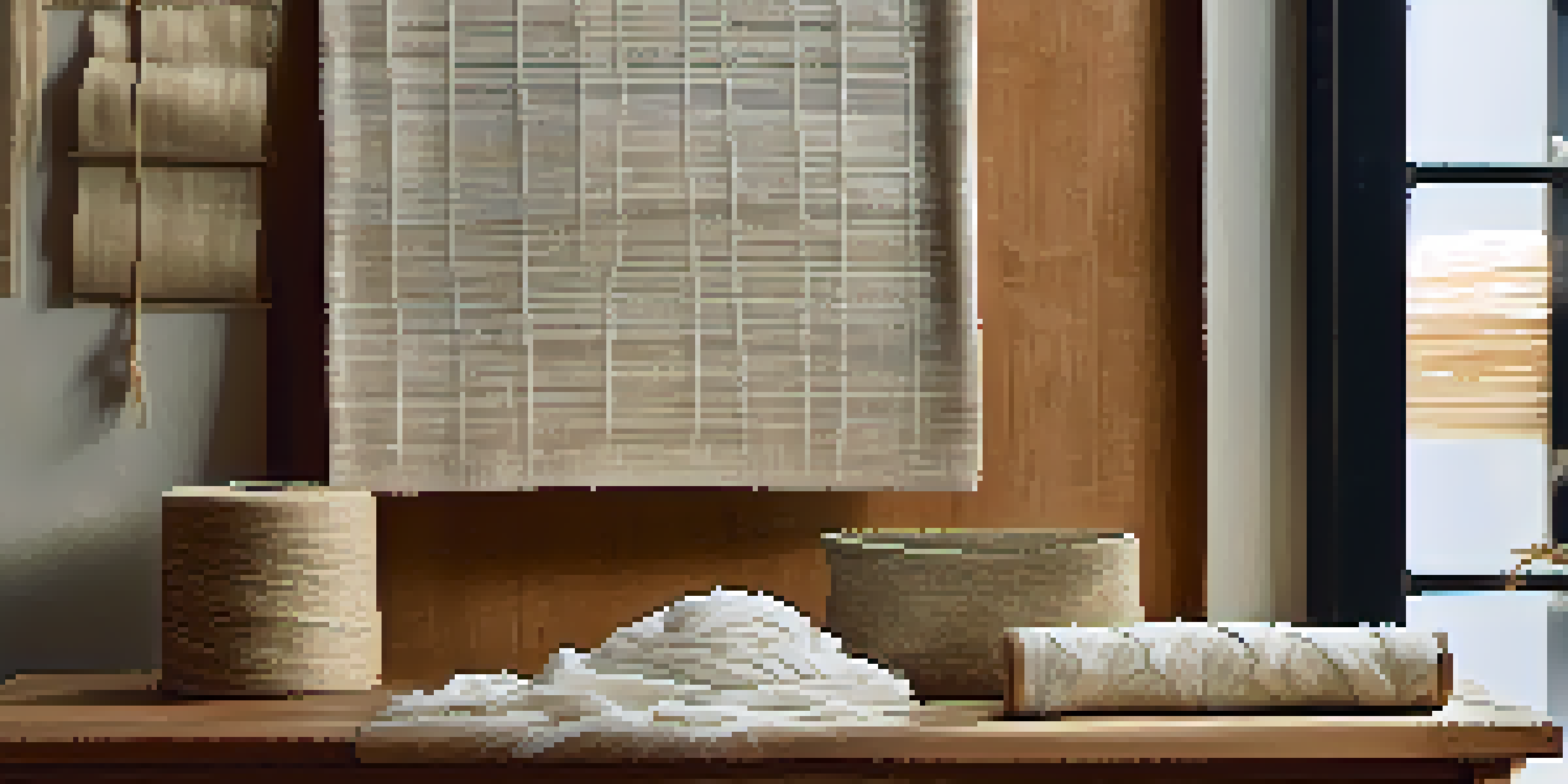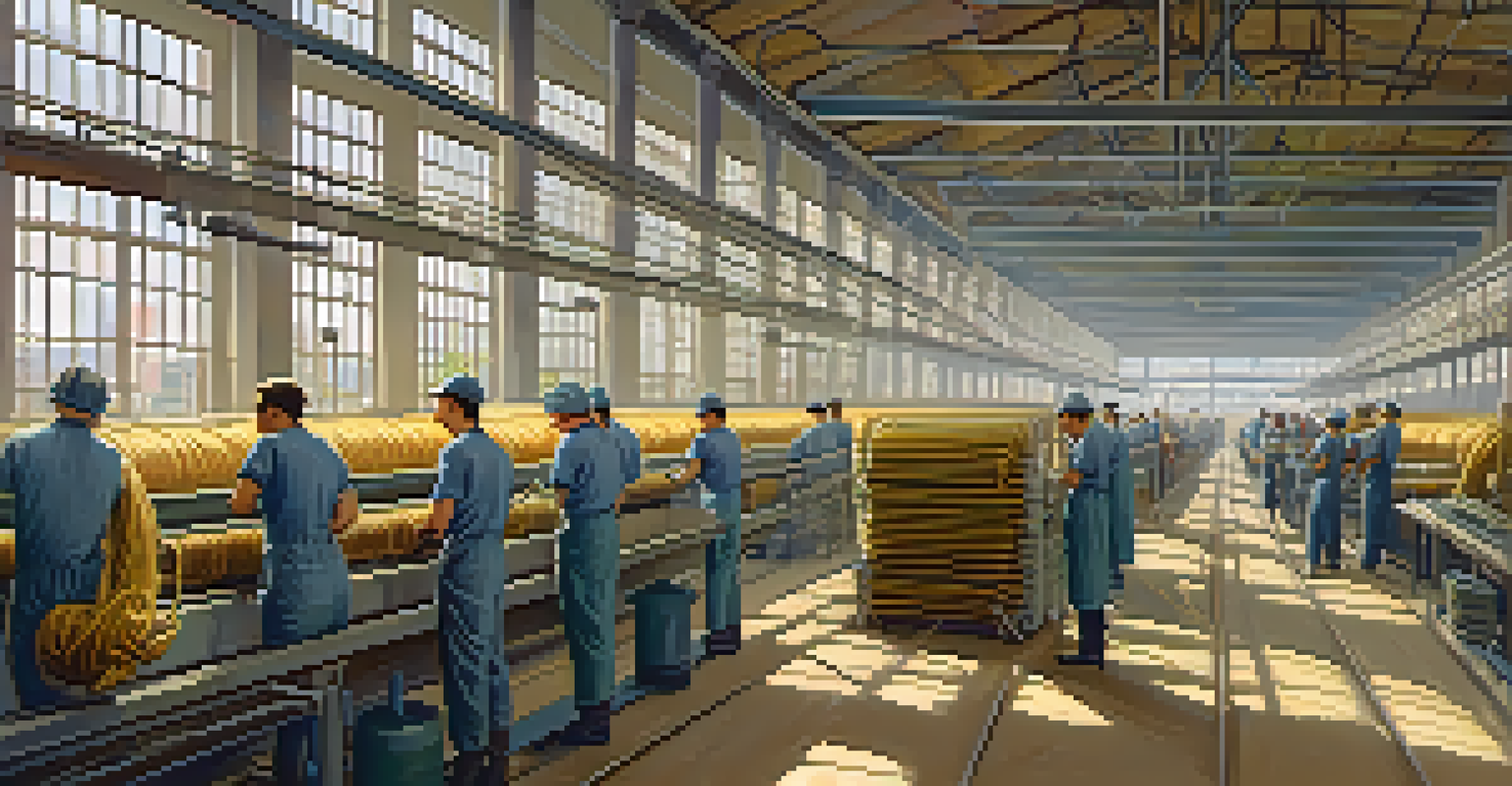Innovative Techniques in Plant Fiber Textile Production

The Rise of Sustainable Plant Fiber Textiles
In recent years, there's been a significant shift towards sustainable fashion, with plant fiber textiles leading the way. These materials, derived from sources like cotton, hemp, and bamboo, not only reduce environmental impact but also offer unique aesthetic qualities. As consumers become more eco-conscious, the demand for these textiles continues to grow, prompting innovative production techniques to emerge.
The greatest threat to our planet is the belief that someone else will save it.
Sustainability isn't just a trend; it's becoming a necessity in the textile industry. This shift encourages brands to explore how they can minimize waste and use renewable resources effectively. By investing in plant fibers, companies are not only addressing environmental concerns but also creating products that resonate with values-driven consumers.
As we delve deeper into plant fiber textiles, understanding their benefits and production methods becomes crucial. This exploration reveals how innovation can meet both the needs of consumers and the planet, paving the way for a more responsible fashion landscape.
Innovations in Fiber Extraction Processes
Fiber extraction is a critical step in textile production, and recent innovations have made this process more efficient and eco-friendly. Traditional methods can be resource-intensive, but new techniques, such as enzymatic extraction, are changing the game. By utilizing natural enzymes, manufacturers can break down plant materials without the harsh chemicals typically used, resulting in a purer fiber.

This eco-friendly approach not only lowers the environmental impact but also enhances the quality of the final product. For instance, enzymatic processes can improve the softness and durability of the fibers, making them more appealing to consumers. As these methods become mainstream, we can expect a positive ripple effect throughout the industry.
Sustainable Textiles on the Rise
The demand for plant fiber textiles is increasing as consumers seek eco-friendly fashion options.
Moreover, the adoption of these innovative extraction methods aligns with global sustainability goals. By reducing waste and energy consumption in fiber production, companies can contribute to a healthier planet while meeting consumer demands for high-quality textiles.
Advancements in Spinning Technologies
The spinning process is crucial for converting raw plant fibers into usable yarn, and innovative technologies are making this step more efficient. Techniques such as open-end spinning and ring spinning are being enhanced with the integration of automation. This not only speeds up production but also allows for more consistent quality in the final yarn.
Sustainability is not just about doing less harm. It’s about doing more good.
Automated spinning technologies can adjust to different fiber types, optimizing the spinning process for various plant materials. This adaptability is essential as the demand for diverse plant fibers, like jute and flax, increases. As a result, manufacturers can offer a wider range of products without compromising on quality or efficiency.
Furthermore, advancements in spinning technologies are creating opportunities for smaller producers to enter the market. With more accessible and efficient equipment, even small-scale farmers can participate in the textile value chain, promoting local economies and sustainable practices.
Innovative Dyeing Techniques for Plant Fibers
Dyeing is a vital step in textile production, and innovative techniques are emerging to make this process more sustainable. Traditional dyeing methods often rely on synthetic dyes, which can be harmful to the environment. However, natural dyeing techniques, utilizing plant-based materials, are gaining popularity and providing vibrant colors without toxic chemicals.
Recent advancements have also improved the efficiency of natural dyeing processes. Techniques such as digital printing allow for precise application of dyes, reducing waste and ensuring that colors remain vibrant. This method not only conserves resources but also opens up new possibilities for creativity in textile design.
Innovations Enhance Production Efficiency
Advancements in extraction and spinning technologies are making textile production more efficient and sustainable.
As designers experiment with these innovative dyeing methods, we're beginning to see a shift in consumer preferences. More and more shoppers are seeking products that reflect their values, and sustainable, naturally dyed textiles are emerging as a favorite choice for eco-conscious consumers.
The Role of Technology in Fiber Blending
Fiber blending is an essential technique in textile production, allowing manufacturers to combine different plant fibers for enhanced qualities. With advancements in technology, the blending process has become more sophisticated, enabling the creation of unique textile properties. For instance, blending cotton with hemp can produce a fabric that is both soft and durable, appealing to a wider audience.
Additionally, new machinery has made it easier to experiment with various fiber combinations. As manufacturers explore innovative blends, they can create textiles that meet specific consumer needs, such as moisture-wicking properties or increased breathability. This level of customization is crucial in a market that values both performance and sustainability.
The rise of technology in fiber blending is not just about improving textile performance; it's also about sustainability. By optimizing fiber combinations, manufacturers can reduce waste and enhance the longevity of their products, contributing to a more sustainable textile industry.
3D Weaving: The Future of Plant Fiber Textiles
One of the most exciting innovations in plant fiber textile production is 3D weaving technology. This method allows for the creation of complex textile structures that traditional weaving cannot achieve. By layering and intertwining fibers in three dimensions, manufacturers can produce fabrics that are not only visually stunning but also highly functional.
3D weaving opens up new avenues for design and application, enabling the creation of textiles with built-in structural integrity. For example, this technology can be used to produce lightweight, strong materials suitable for everything from fashion to automotive applications. As designers embrace this method, the possibilities for plant fiber textiles are expanding exponentially.
Consumer Awareness Drives Change
Informed consumers are pushing brands to adopt sustainable practices and innovate production techniques.
Moreover, 3D weaving aligns with the principles of sustainability by minimizing waste. Unlike traditional methods that often require cutting and sewing, 3D weaving can create shapes directly from the loom, reducing material waste and promoting a more efficient production process.
The Impact of Consumer Awareness on Production Techniques
Consumer awareness plays a pivotal role in shaping the textile industry, especially in plant fiber production. As shoppers become more informed about the environmental impact of their choices, they increasingly demand sustainable options. This shift in consumer behavior pushes manufacturers to adopt innovative techniques that prioritize eco-friendliness and ethical practices.
The rise of social media and online platforms has amplified this awareness, allowing consumers to share their values and preferences more widely. Brands that respond to these demands by embracing sustainable practices and transparent production processes are more likely to resonate with today's conscientious shoppers. This connection not only builds brand loyalty but also encourages a broader industry shift towards sustainability.

Ultimately, the impact of consumer awareness on production techniques is profound. As more individuals advocate for sustainable practices, manufacturers are compelled to innovate, leading to a textile industry that values both quality and environmental responsibility.